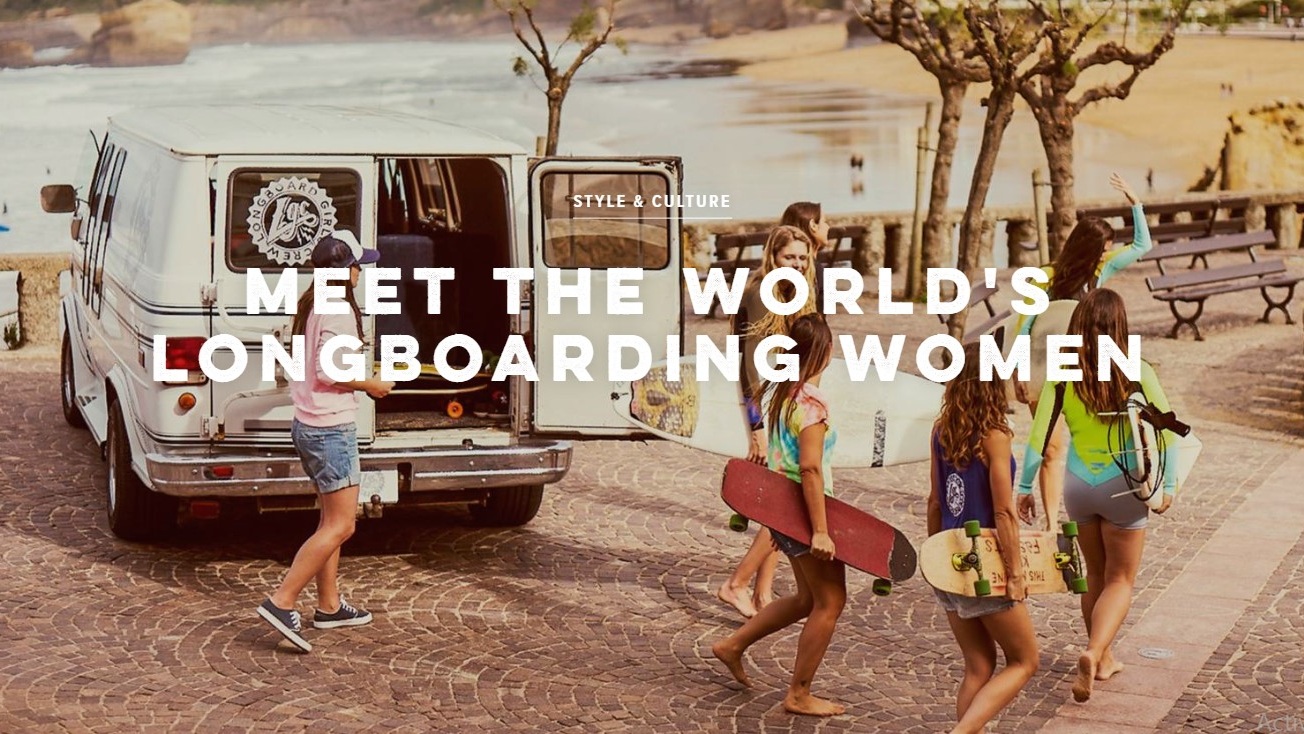When Valeria Kechichian started longboarding in Madrid in 2008, there were just three other women in her crew. It represented freedom; an escape from a soul-crushing job as a secretary in a law firm and a self-destructive spiral of partying. ‘It was this very pure kind of joy,’ she says. ‘It completed me somehow.’ Still, when she first stood on a board in the Spanish capital, people would ‘turn their heads and look at me as if I was doing something weird’.
It’s fair to say that Argentinian-born Kechichian’s gang has grown a bit. Longboard Girls Crew (LGC), which she co-founded in 2010, now claims to be the world’s biggest action-sports community, with 233,400 Facebook followers and counting, and representatives in 70 countries. With some of its videos being viewed as many as 3.6 million times on YouTube, the group has ignited an international scene built on female empowerment and dreamy images of cruising golden-hour open roads. Kechichian has become the global face of it all, launching and partnering with NGOs, giving TEDx Talks and motivating Nike ambassadors and Facebook employees with the free-wheeling gospel.
The sport was invented in Hawaii in the 1950s, when surfers started customising skateboards with bigger wheels and looser trucks to make them more like surfboards. These Hawaiian pioneers would drive up volcanoes and glide down, carving S-shaped turns as if on a peeling wave. Over the years, longboarders developed tricks and started speeding down hills at more than 90mph – but the primary appeal has always been a certain languorous elegance; a free-spirited surfer vibe, more at home in nature than gritty skateboarding. There’s a scene in The Secret Life of Walter Mitty, of Ben Stiller whizzing alone through the mossy Icelandic landscape, grinning at the wild freedom of it all.
That spirit is central to the movement, which includes all kinds of women across the world. In Nice, Marina Corrêa spins along the old boardwalk, flicking her dreadlocks to a reggaeton soundtrack. Seoul freestyle longboarder Ko Hyojoo (pictured below) is the queen of a flourishing Korean community, dancing on her board in cute knee-high socks to the tune of 568,000 Instagram followers and partnerships with Chanel and Gucci. Chinese boarder Mu Qing skates through Chengdu in a hoodie and Vans, filmed by a friend on a smartphone for her 500,000 followers on the Douyin video app. In Malaysia, Fatin Amalina whooshes between Kuala Lumpur’sshiny skyscrapers in a hijab.
The riding styles are as diverse as the women. On the Venice Beach Boardwalk, Natalie Pluto (pictured below) is part of a small band of balletic freestylers, doing kick-flips and shove-its as she weaves among the tourists. Based in Virginia, Emily Pross, who styles herself ‘the Prossecutor’, wears a shiny black speed suit and aerodynamic helmet to beat the men in downhill races – her speed record is 83.88mph. All of them are celebrated on the LGC social feeds, from the cruisers to the leather-clad competitors posting under the #girlscanride hashtag.
The group had its Endless Summer moment in 2011, with a film of seven women road-tripping across Spain and the Balearics in a red VW camper van, riding their boards through white-stone villages and down sun-flared roads overlooking limestone cliffs. Endless Roads, the result of this 2,670-mile journey, became a clarion call for a certain type of female-powered adventure, with 1.4 million views on YouTube. ‘It was more rare for something to go viral back then,’ says Kechichian. ‘But our video was suddenly everywhere. It resonated with women who thought, “Hey, we can do this.” It started a global movement.’
One of the people who watched Endless Roads on repeat was a teenage Valeriya Gogunskaya (pictured above), who lived in the forested Finnish city of Kuopio. ‘It just looked super-cool,’ she says. ‘I used to roller-skate, and I gave my skates to a friend in exchange for his longboard. I downloaded some YouTube tutorials and started cruising.’ A year later, Gogunskaya moved to Santa Cruz, a beach town north of Lisbon, with hopes of finding other skaters: ‘There was just one guy there at the time. I was always whining to my boyfriend that there was no one to skate with. He said, “Why don’t you start something?”’ Inspired by LGC, Gogunskaya organised a meet-up in 2017 at Praia de Santa Cruz’s white-stone-balustered platform, which looks out over the hazy, rocky coastline. To her surprise, around 30 people showed up – almost all of them female. She launched a skate camp, Longboarding Days and Nights, and single-handedly sparked a scene in Santa Cruz, where many are now women in their 30s and 40s.
Gogunskaya practises most evenings, carving wide turns and hanging 10 like the old-school surfers. Just as Kechichian used longboarding as a form of therapy, Gogunskaya applied her passion to face down her own challenges. ‘I began when I was struggling with bulimia,’ she says. ‘It helped me relax, nurture self-love and respect my body again. I just want to share that chance with other people, especially women.’
But while Gogunskaya and Kechichian have both used longboarding as a way to process their issues, behind it all is still that simple, joyous feeling of gliding along a road: ‘When I’m skating, that’s all that matters,’ says Kechichian. ‘Me, my board and the road. It creates some sort of magic, a bubble where nothing else matters… You feel like you rule the world.’
